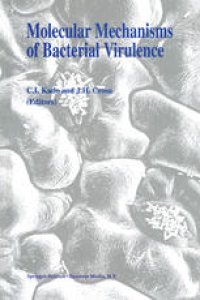
Ebook: Molecular Mechanisms of Bacterial Virulence
- Tags: Plant Pathology, Plant Sciences, Bacteriology, Ecology
- Series: Developments in Plant Pathology 3
- Year: 1994
- Publisher: Springer Netherlands
- Edition: 1
- Language: English
- pdf
The growing body of information on bacteria pathogenic for humans, mammals and plants generated within the past ten years has shown the interesting conservation of newly identified genes that playa direct role in the pathogenic mechanism. In addition to these genes, there are also genes that confer host specificities and other traits important in pathogenesis on these pathogens. In this volume, we have organized the subject areas to best fit the concept on the way bacterial pathogens recognize, interact and invade the host, on the regulation of genes involved in virulence, on the genes involved in the elaboration of toxins and other pathogenic components such as iron sequestering proteins, and on the mechanisms of circumventing the host defense systems. These areas are divided into Sections. Section I covers the first step when the pathogen seeks its host, and Sections II through VI cover subsequent steps leading to pathogenesis while avoiding host defenses. We conclude this work with a chapter summarizing information on examples of virulence mechanisms that are highly conserved.
This is the first volume to bring together the studies on the differences and profound similarities in the molecular mechanism of virulence between bacteria pathogenic for humans, animals and plants. The volume contains the following sections: 1. Host cell recognition and binding; 2. Pathogen ingression and invasive mechanism; 3. Enzymes, toxins and other pathogenic factors; 4. Regulation of virulence genes and signal transduction; 5. Pathogen of host-defense mechanisms.
This is the first volume to bring together the studies on the differences and profound similarities in the molecular mechanism of virulence between bacteria pathogenic for humans, animals and plants. The volume contains the following sections: 1. Host cell recognition and binding; 2. Pathogen ingression and invasive mechanism; 3. Enzymes, toxins and other pathogenic factors; 4. Regulation of virulence genes and signal transduction; 5. Pathogen of host-defense mechanisms.
Content:
Front Matter....Pages i-xxvii
Front Matter....Pages 1-1
Phenotypic and genetic aspects of host cell invasion by Salmonella species....Pages 3-16
Molecular escorts required to present bacterial adhesins to eukaryotic receptors....Pages 17-30
Studies on the pili of the promiscuous plasmid RP4....Pages 31-45
Fimbria (pilus) mediated attachment of Pseudomonas syringae, Erwinia rhapontici and Xanthomonas campestris to plant surfaces....Pages 47-65
Attachment of Agrobacterium tumefaciens to host cells....Pages 67-77
Effects of Opa proteins and lipooligosaccharides on surface charge and biological behavior of gonococci....Pages 79-92
Anthrax toxin mechanisms of receptor binding and internalization....Pages 93-108
Front Matter....Pages 109-125
Iron and plant pathogenesis: the systemic soft rot disease induced by Erwinia chrysanthemi 3937 on saintpaulia plants....Pages 127-139
Characterization of the Vibrio cholerae heme iron transport system and its role in pathogenesis....Pages 141-158
Toxin secretion in Bordetella pertussis: breaking the Gram-negative barrier....Pages 159-159
Factors affecting the virulence of soft rot Erwinia species: the molecular biology of an opportunistic phytopathogen....Pages 161-171
Processing of the T-DNA from the Agrobacterium tumefaciens Ti-plasmid....Pages 173-184
T-DNA transfer from Agrobacterium to the plant cell nucleus....Pages 185-191
Molecular pathogenesis of viridans streptococcal endocarditis....Pages 193-206
Method for detecting gene expression of internalized Salmonella typhimurium in macrophages....Pages 207-222
Front Matter....Pages 223-230
Front Matter....Pages 231-248
Extracellular virulence factors of Pseudomonas solanacearum: role in disease and regulation of expression....Pages 249-265
RTX-toxins in Actinobacillus pleuropneumoniae and their potential role in virulence....Pages 267-280
The role of extracellular polysaccharides as virulence factors for phytopathogenic pseudomonads and xanthomonads....Pages 281-281
Characterization of genes involved in phaseolotoxin production and its thermal regulation....Pages 283-292
Application of capillary liquid chromatography — electrospray mass spectrometry to identify major siderophores of Erwinia amylovora as proferrioxamines and their potential role in virulence....Pages 281-281
Front Matter....Pages 293-309
Transcriptional elements in Pasteurella haemolytica leukotoxin expression....Pages 311-324
Regulation of Agrobacterium tumefaciens virulence gene expression....Pages 325-340
Conservation of the lema gene, a virulence regulator from the plant pathogen Pseudomonas syringae, within a human pathogenic bacterium....Pages 341-356
Regulation of Shigella virulence expression....Pages 357-378
Front Matter....Pages 379-397
Physiology of resistant interactions between Xanthomonas oryzae pv. oryzae and rice....Pages 399-414
Developments in the interaction of bacterial avirulence genes and plant disease resistance genes....Pages 415-428
Front Matter....Pages 429-444
Anti-host-defense systems are elaborated by plant pathogenic bacteria....Pages 445-445
Organization, regulation and function of Pseudomonas syringae pv. syringae hrp genes....Pages 447-462
The role of indoleacetic acid production by Pseudomonas syringae pathovars on their pathogenicity on host plants....Pages 463-475
Genes governing the secretion of factors involved in host-bacteria interactions are conserved among animal and plant pathogenic bacteria....Pages 477-489
Defining the contribution of the Agrobacterium chromosome in crown gall tumorigenesis....Pages 491-504
Back Matter....Pages 505-510
....Pages 511-524